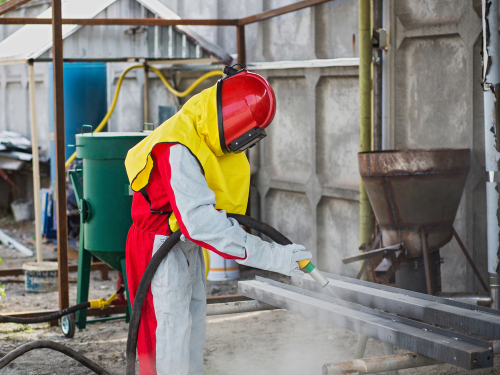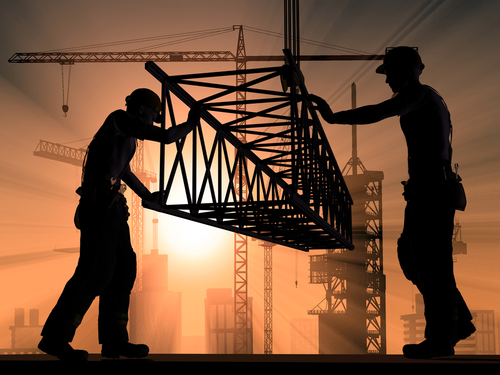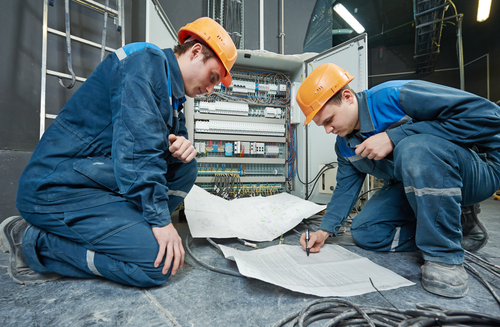About fifteen years ago, a friend of mine made me two metal three-tier plant stands from a photograph I provided to him. These stands were ideal for the small patio and garden area which were the main entertainment and gardening areas available to us at the time. The stands have been used continuously since then, even though we have moved houses a few times over the years, and the gardening area has both grown and then diminished with each move. A lot of my attachment to these plant stands is due to sentimental reasons and memories of a highly talented craftsman who has, sadly, since passed away.

These specialists clean and prepare areas faster, more efficiently and with better results
My biggest problem now is the fact that, although I have protected the metal with rust-inhibiting coatings over the years, time and the weather are beginning to win in my war of preservation, and rust and weak spots are now taking their toll on these two stands. I know that sanding alone will not resolve the problem, and I need to cut through the various protective and paint layers to start the process from the inside-out, so to speak. To try and do this by hand will be both time consuming and most probably not completely effective, so the obvious answer is to call in a sandblasting and coating specialist who can do the job professionally and quickly – and save my precious plant stands.
Both water and air can be used to carry the abrasive medium
Sandblasting specialists are able to use the combined power of various types of abrasive grit and either air or water to blast through layers of old paint, rust, mould, accumulated and ingrained dirt and grease in short order. Many of us know the effective results that a water pressure sprayer alone can produce in cleaning surface dirt and mould off outdoor cement and patio tiles, but if you include the additional element of a sanding medium to the mix, the effect is incredibly powerful. For those areas which are likely to be damaged by being subjected to water treatments, this sanding grit can be applied using high-pressure air delivery alone. Metals are a difficult medium in one way, in that they will oxidise almost immediately once exposed to moisture, and need to be coated extremely quickly with a rust-inhibitor to prevent the ingress of rust. Very often, metal which is able to hold an electrostatic charge is coated with a fine electrostically-charged plastic powder, which is then baked at very high temperatures which melt the powder onto the metal and provide a smooth and extremely effective protective finish. This is aptly called powder-coating. Nonetheless, this finish will inevitably, over a period of years, become brittle and break down if left outdoors year-round, and rust will be quick to make use of cracks to establish its hold on the metal once again. It seems to me that the best solution for metal which is constantly subjected to extremes in weather – which are ideal breeding grounds for rust – is a regime every few years of sandblasting and re-coating with a good metal protector. This is especially recommended for metal items like benches, chairs, tables, chimineas, balustrades and balconies in the French, Juliet, Faux styles, etc., as well as mezzanine balconies all of which have highly decorative finishes such as scrolls, flowers, or other forms of adornment. Mezzanine balconies are indoor balconies which are obviously less exposed to moisture and heat, but still need to be cleaned once or twice in their lifespans. Some older houses, especially those in the Victorian style, still have the original “broekielace” borders around their gutter lines and even topping some balustrades. All of these highly ornamental metal items are definitely attractive in the right setting and do create an air of opulence or whimsy, but the maintenance is a major drawback. One has only to imagine how long it would take to manually sand down each nook and cranny and then almost immediately treat it against rust as you progress. My heart quails at the thought, as I am sure many others would as well!
What else can they do?
It could be that you simply want to spruce up your swimming pool mosaics or tiles and clean off the accumulated grime of a hard winter or three. There is a sandblasting specialist who will be able to assist you. Perhaps your wooden outdoor furniture needs to be cleaned of old paint or varnish in preparation for a new coating? Even if you have an electric sander of your own, it is still going to take a lot of work, disassembly and reassembly of the furniture before the job is finished to a standard which looks good and will last for another few years. If you can, call in the sandblasting specialists to do the hard preparation work for you. Do you want to upgrade the clear glass in your cabinets by having a unique design sandblasted into their surface or want to hide untidy cabinet interiors behind a ‘frosted’ glass frontage? And yes, a sandblasting specialist can assist you here as well.
What sort of abrasives are used in sandblasting?
Sandblasting specialists work with a variety of sanding mediums, according to the object which needs to be cleaned. These range from aluminium oxide grit, steel grit, copper shot, zinc shot, platinum slag, crushed glass grit and glass beads for metal applications, depending on the severity of the cleaning, shaping and smoothing to be carried out. Normal playsand is not advised as it produces free silica and crystalline silica which is extremely dangerous if inhaled and can lead to silicosis, which scars the lungs and can lead to severe illness and even death. Even so, sand is still one of hardest mediums available for sandblasting (hence the name), and is still used in etching stone and glass engraving. If the items to be sandblasted with sand are in a sealed and contained area which does not allow for inhalation of the sand, such as a sandblasting cabinet, then it is possible to work safely, but since there are so many other safe mediums available, it would be wisest to choose something else if at all possible.
Save time and aggravation – use a specialist!
In a short article such at this, it is not possible to go into the many uses of sandblasting in any great depth, but it is a wide subject and its applications are many and varied, from wood to plastic to glass to softer or harder metals. Whatever your needs are, if the job is too arduous or large for you to tackle yourself, by all means get hold of a recommended and knowledgeable sandblasting and coating specialist and save yourself time, effort and aggravation. It really will be worth it!

